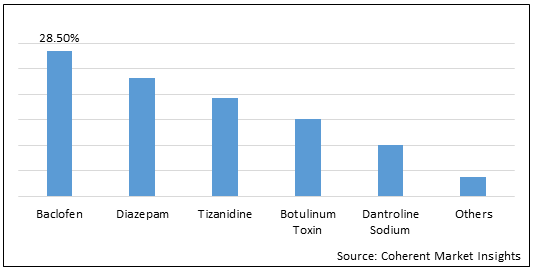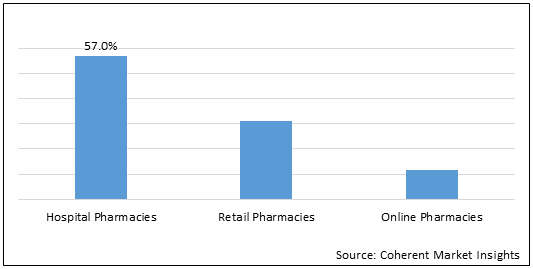Muscle spasticity is a condition in which muscles contract, become stiff, or spasm involuntarily. The muscles contract making it difficult to stretch, walk, move, and talk. Spasticity is caused by damage to the areas of brain and spinal cord that are responsible for stretch reflexes and controlling muscle. This can be due to imbalance in the inhibitory and excitatory signals sent to the muscles. People with brain injury, spinal cord injury, multiple sclerosis, cerebral palsy, or stroke can have different degrees of spasticity.
The global spasticity market is estimated to be valued at US$ 4,167.6 million in 2021 and is expected to exhibit a CAGR of 8.9% during the forecast period (2021-2028).
Figure 1.Global Muscle Spasticity Market Share (%) in Terms of Value, By Drug Type, 2021

To learn more about this report, Download Free Sample
Increasing prevalence of stroke, multiple sclerosis, and brain injury is expected to drive the market growth during the forecast period.
An increase in the prevalence of strokes, multiple sclerosis, and brain injuries is expected to drive the market growth during the forecast period. For instance, according to an article published in ‘International Journal of Neurorehabilitation’, in 2016, in America, approximately 795,000 people experience stroke each year, with around 610,000 of those being reported to be the first incidence of stroke. Research into spasticity prevalence in first stroke survivors indicates that up to 20-43% may experience some spasticity as a result of the injury.
Muscle Spasticity Market Report Coverage
| Report Coverage | Details | ||
|---|---|---|---|
| Base Year: | 2020 | Market Size in 2021: | US$ 4,167.6 Mn |
| Historical Data for: | 2017 to 2020 | Forecast Period: | 2021 to 2028 |
| Forecast Period 2021 to 2028 CAGR: | 8.9% | 2028 Value Projection: | US$ $ 7,560.6 Mn |
| Geographies covered: |
|
||
| Segments covered: |
|
||
| Companies covered: |
Ipsen Pharma, Allergan, Acorda Therapeutics, Inc., Merz Pharma, Teva Pharmaceutical Industries Ltd., Novartis AG, Sun Pharmaceutical Industries Ltd., Beximco Pharmaceuticals Ltd., Johnson & Johnson Private Limited, Zydus Cadila, F. Hoffmann-La Roche Ltd., and Elite Pharmaceuticals Inc |
||
| Growth Drivers: |
|
||
| Restraints & Challenges: |
|
||
Uncover macros and micros vetted on 75+ parameters: Get instant access to report
Figure 2.Global Muscle Spasticity Market Share (%), By Distribution Channel, 2021

To learn more about this report, Download Free Sample
Increasing research and development for developing effective therapies is expected to drive the market growth during the forecast period.
The increasing research and development of new and effective therapies for the treatment of muscle spasticity is expected to drive the market growth during the forecast period. For instance, in November 2021, Aditum Bio, the biotech investment firm for BioMedical Research, announced the formation of Motric Bio, a portfolio company developing a new therapy for spasticity associated with neurological injuries and disease. Current treatments target the central nervous system (CNS), with many causing cardiovascular and neurological side effects. Myosin-2 inhibitor molecule, which is to be developed by Motric Bio, has shown selectivity to fast skeletal myosin-2, with practically no inhibition of cardiac and smooth muscle myosins. This could lead to greater efficacy and fewer side effects than the current standard of care.
Global Muscle Spasticity Market– Impact of Coronavirus (COVID-19) Pandemic
COVID-19 has considerably impacted the muscle spasticity market. Most of the activities involved in the treatment of muscle spasticity have been either postponed or suspended. This prolonged suspension of activities has potentially exposed a lot of patients to the consequences of untreated spasticity.
COVID-19 has caused home confinement of patients, which may have triggered spasticity. For instance, according to an article published in ‘BioMed Research International journal’ on October 2021, both the number and the duration of oscillations (right leg), as well as the first swing excursion and relaxation index (left leg), decreased after home confinement, indicating increased spasticity.
Moreover, spasticity is a multifactorial problem, which is also influenced by psychological and behavioral aspects. COVID-19 has impacted the behavioral and psychological health of individuals (e.g., anxiety, fear of infection, and poorer sleep quality), which may have contributed to increased spasticity in people with multiple sclerosis.
Global Muscle Spasticity Market: Restraint
The major factors that hinder the growth of the global muscle spasticity market include lack of availability of skilled professionals, overall high cost of treatment, inadequate reimbursement, and lack of disease awareness in emerging economies.
Key Players
Major players operating in the global muscle spasticity market include Ipsen Pharma, Allergan, Acorda Therapeutics, Inc., Merz Pharma, Teva Pharmaceutical Industries Ltd., Novartis AG, Sun Pharmaceutical Industries Ltd., Beximco Pharmaceuticals Ltd., Johnson & Johnson Private Limited, Zydus Cadila, F. Hoffmann-La Roche Ltd., and Elite Pharmaceuticals Inc.
Share
Share
Missing comfort of reading report in your local language? Find your preferred language :
Transform your Strategy with Exclusive Trending Reports :
Frequently Asked Questions
Select a License Type
Joining thousands of companies around the world committed to making the Excellent Business Solutions.
View All Our Clients